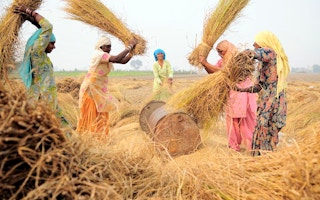India’s ban on wheat exports has denied the country’s farmers and traders an opportunity to earn money from the sale of wheat in the global market that is currently facing shortages of the prime staple as a result of Russia’s war in Ukraine, say analysts.
India produced an estimated 107.9 million tonnes of the grain in 2020—2021, second only to China with 134.3 million tonnes. Russia came in third with 85.4 million tonnes.
Farmers’ hopes were raised when the government announced on 12 May plans to export 10 million tonnes of wheat during 2022—2023 and identified Algeria, Egypt, Indonesia, Lebanon, Morocco, Philippines, Thailand, Tunisia, Turkey and Vietnam among potential buyers.
But two days later, the trade department under the Ministry of Commerce and Industry did an about-turn by issuing a notification restricting wheat exports except through government channels and where private traders had already contracted export deals.
“Raising expectations of making good the global supply shortfall and then back-tracking creates a real problem,” said Biswajit Dhar, professor and head of the Centre for WTO Studies, New Delhi. “Trade channels seek reliable suppliers for good reasons and India’s credibility would therefore take a hit — future exports could be affected as a result.”
“
What we are actually staring at is a failure of policy. Farmers and traders need a predictable policy environment.
Kavitha Kuruganti, president, Alliance for Sustainable and Holistic Agriculture
During a press conference on 14 May, Commerce Secretary B.V.R. Subrahmanyam explained that the export restrictions would help domestic food security, as well as neighbouring and vulnerable countries. Afghanistan, Bangladesh and Sri Lanka are among neighbouring countries that receive wheat from India.
Subrahmanyam said the restrictions could be lifted “if the global supply and demand is the same and once cooling (of prices) happens”.
India’s ban on wheat exports drew criticism from the Group of Seven (G7) countries with German food and agriculture minister Cem Özdemir saying at a press conference in Stuttgart on 20 May that if countries begin imposing export restrictions it could only worsen shortages.
While the bulk of India’s wheat production is consumed locally, the country has increasing presence in the global markets. In the 2021—2022 financial year India exported 7.85 million tonnes of the grain which was more than four times the 2.1 million tonnes exported in the preceding fiscal year.
Dhar said it was interesting that China has defended India’s move to control wheat exports. “Blaming India won’t solve the food problem, although there is no denying that India’s move to stop its wheat exports may push up wheat prices a little bit,” Global Times, the Chinese government-controlled portal said on 15 May. “Why won’t the G7 nations themselves move to stabilise food market supply by hiking their exports?”
There were other compelling reasons that prompted the government to restrict wheat exports. “Private traders, sensing the rise in global prices of wheat, were suddenly buying up stocks at rates higher than the government’s minimum support price,” said Devinder Sharma, food and policy analyst and founder member of Kisan Ekta Morcha, an umbrella organisation for more than 65 farmers’ groups.
Sharma said past experience had shown that allowing free trade helps traders rather than farmers or consumers. “There were times when traders mopped up so much grain that the government had to import wheat at twice the price at which it had been exported months earlier.”
Said Dhar: “Given the nature of India’s agricultural markets and the stranglehold of traders, it is unlikely that exports would have directly benefited the farmers. Unless farmers are more organised and develop better bargaining power, they would have difficulties in taking advantage of the favourable circumstances in the international market.”
The main government constraint is that it is committed to providing some 800 million Indians highly subsidised food grains under the National Food Security Act. Each beneficiary is entitled to five kilograms of grains per month at Rupees 3 (US$0.039) per kilogram for rice and Rupees 2 (US$0.013) per kilogram for wheat.
Sharma said it was important for the government to maintain large buffer stocks, or public stockholding, against unpredictable events like monsoon failures or the recent heat waves which affected harvests. “During the pandemic, India could distribute subsidised grain only because bumper harvests over the last five years had allowed the building of 50 million tonnes of surplus stock.”
“What we are actually staring at is a failure of policy arising from lack of reliable data systems with different ministries unable to coordinate with each other,” said Kavitha Kuruganti, leader of the Alliance for Sustainable and Holistic Agriculture, a national network that promotes farmers’ rights and food security.
“Farmers and traders need a predictable policy environment. Also, there should be no mid-way changes in export-import policies between sowing season and marketing,” Kuruganti said.
“Right now, the government could offer a bonus over the minimum support price,” she said. “That way, enough stocks can be ensured for poor consumers, while not penalising farmers who have been waiting for higher prices from exports but lost out thanks to ad-hoc decision-making and policy flip-flops.”
A mega policy flip-flop happened when the government was forced by striking farmers to repeal in November 2021 laws aimed at freeing up controls on the marketing of farm produce and doing away with the minimum support price for commodities that had become a budgetary burden.
This article was originally published on SciDev.Net. Read the original article.










